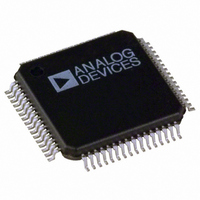ADV7343BSTZ Analog Devices Inc, ADV7343BSTZ Datasheet - Page 63

ADV7343BSTZ
Manufacturer Part Number
ADV7343BSTZ
Description
IC ENCODER VIDEO W/DAC 64-LQFP
Manufacturer
Analog Devices Inc
Type
Video Encoderr
Datasheet
1.ADV7343BSTZ.pdf
(104 pages)
Specifications of ADV7343BSTZ
Applications
DVD, Blu-Ray
Voltage - Supply, Analog
3.3V
Voltage - Supply, Digital
1.8V
Mounting Type
Surface Mount
Package / Case
64-LQFP
Supply Voltage Range
1.71V To 1.89V
Operating Temperature Range
-40°C To +85°C
Tv / Video Case Style
LQFP
No. Of Pins
64
Svhc
No SVHC (18-Jun-2010)
Operating Temperature Max
85°C
Operating
RoHS Compliant
Input Format
Digital
Output Format
Analogue
Dac Resolution
11bit
Rohs Compliant
Yes
Lead Free Status / RoHS Status
Lead free / RoHS Compliant
Available stocks
Company
Part Number
Manufacturer
Quantity
Price
Company:
Part Number:
ADV7343BSTZ
Manufacturer:
ADI
Quantity:
301
Company:
Part Number:
ADV7343BSTZ
Manufacturer:
Analog Devices Inc
Quantity:
10 000
Part Number:
ADV7343BSTZ
Manufacturer:
ADI/亚德诺
Quantity:
20 000
Company:
Part Number:
ADV7343BSTZ-3
Manufacturer:
ADI
Quantity:
246
When the adaptive filter mode is changed to Mode B
(Subaddress 0x35, Bit 6), the output shown in Figure 76
can be obtained.
SD DIGITAL NOISE REDUCTION
Subaddress 0xA3 to Subaddress 0xA5
Digital noise reduction (DNR) is applied to the Y data only.
A filter block selects the high frequency, low amplitude compo-
nents of the incoming signal (DNR input select). The absolute
value of the filter output is compared to a programmable
threshold value (DNR threshold control). There are two DNR
modes available: DNR mode and DNR sharpness mode.
In DNR mode, if the absolute value of the filter output is smaller
than the threshold, it is assumed to be noise. A programmable
amount (coring gain border, coring gain data) of this noise
signal is subtracted from the original signal. In DNR sharpness
mode, if the absolute value of the filter output is less than the
programmed threshold, it is assumed to be noise. Otherwise, if
the level exceeds the threshold, now identified as a valid signal,
a fraction of the signal (coring gain border, coring gain data) is
added to the original signal to boost high frequency components
and sharpen the video image.
In MPEG systems, it is common to process the video information
in blocks of 8 pixels × 8 pixels for MPEG2 systems or 16 pixels ×
16 pixels for MPEG1 systems (block size control). DNR can be
applied to the resulting block transition areas that are known to
contain noise. Generally, the block transition area contains two
pixels. It is possible to define this area to contain four pixels
(border area).
It is also possible to compensate for variable block positioning
or differences in YCrCb pixel timing with the use of the DNR
block offset.
The digital noise reduction registers are three 8-bit registers.
They are used to control the DNR processing.
Figure 76. Output Signal from ED/HD Adaptive Filter (Mode B)
Rev. A | Page 63 of 104
Coring Gain Border—Subaddress 0xA3, Bits[3:0]
These four bits are assigned to the gain factor applied to border
areas. In DNR mode, the range of gain values is 0 to 1 in
increments of 1/8. This factor is applied to the DNR filter
output that lies below the set threshold range. The result is then
subtracted from the original signal.
In DNR sharpness mode, the range of gain values is 0 to 0.5 in
increments of 1/16. This factor is applied to the DNR filter
output that lies above the threshold range. The result is added to
the original signal.
Coring Gain Data—Subaddress 0xA3, Bits[7:4]
These four bits are assigned to the gain factor applied to the luma
data inside the MPEG pixel block. In DNR mode, the range of
gain values is 0 to 1 in increments of 1/8. This factor is applied
to the DNR filter output that lies below the set threshold range.
The result is then subtracted from the original signal.
In DNR sharpness mode, the range of gain values is 0 to 0.5 in
increments of 1/16. This factor is applied to the DNR filter
output that lies above the threshold range. The result is added to
the original signal.
Y DATA
Y DATA
INPUT
INPUT
DNR MODE
DNR
SHARPNESS
MODE
NOISE
SIGNAL PATH
NOISE
SIGNAL PATH
INPUT FILTER
INPUT FILTER
MAIN SIGNAL PATH
MAIN SIGNAL PATH
BLOCK
BLOCK
Figure 77. SD DNR Block Diagram
< THRESHOLD?
> THRESHOLD?
BLOCK SIZE CONTROL
CORING GAIN BORDER
BLOCK SIZE CONTROL
CORING GAIN BORDER
OUTPUT
OUTPUT
FILTER
CORING GAIN DATA
FILTER
CORING GAIN DATA
FILTER OUTPUT
< THRESHOLD
BLOCK OFFSET
BLOCK OFFSET
BORDER AREA
FILTER OUTPUT
DNR CONTROL
BORDER AREA
DNR CONTROL
> THRESHOLD
GAIN
GAIN
ADV7342/ADV7343
+
+
–
+
SUBTRACT
SIGNAL IN
THRESHOLD
RANGE FROM
ORIGINAL SIGNAL
ADD SIGNAL
ABOVE
THRESHOLD
RANGE FROM
ORIGINAL SIGNAL
DNR OUT
DNR OUT













